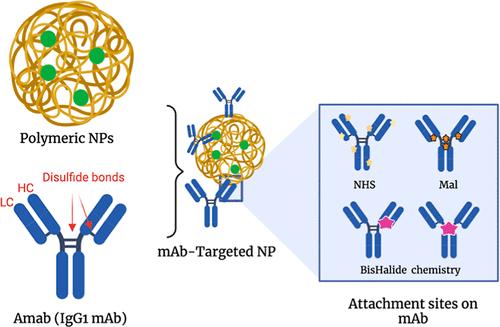Facile Rebridging Conjugation Approach to Attain Monoclonal Antibody-Targeted Nanoparticles with Enhanced Antigen Binding and Payload Delivery
引用次数: 0
Abstract
Adopting conventional conjugation approaches to construct antibody-targeted nanoparticles (NPs) has demonstrated suboptimal control over the binding orientation and the structural stability of monoclonal antibodies (mAbs). Hitherto, the developed antibody-targeted NPs have shown proof of concept but lack product homogeneity, batch-to-batch reproducibility, and stability, precluding their advancement toward the clinic. To circumvent these limitations and advance toward clinical application, herein, a refined approach based on site-specific construction of mAb-immobilized NPs will be appraised. Initially, the conjugation of atezolizumab (anti-PDL1 antibody, Amab) with polymeric NPs was developed using bis-haloacetamide (BisHalide) rebridging chemistry, followed by click chemistry (NP-Fab BisHalide Ab and NP-Fc BisHalide Ab). For comparison purposes, mAb-immobilized NPs developed utilizing conventional conjugation methods, namely, N-hydroxysuccinimide (NHS) coupling and maleimide chemistry (NP-NHS Ab and NP-Mal Ab), were included. Next, flow cytometry and confocal microscopy experiments evaluated the actively targeted NPs (loaded with fluorescent dye) for cellular binding and uptake. Our results demonstrated the superior and selective binding and uptake of NP-Fab BisHalide Ab and NP-Fc BisHalide Ab into EMT6 cells by 19-fold and 13-fold, respectively. To evaluate the PDL1-dependent cell uptake and the selectivity of the treatments, a blocking step of the PDL1 receptor with Amab was performed prior to incubation with NP-Fab BisHalide Ab and NP-Fc BisHalide Ab. To our delight, the binding and uptake of fluorescent NPs were reduced significantly by 3-fold for NP-Fab BisHalide Ab, demonstrating the PDL1-mediated uptake. Moreover, NP-Fab BisHalide Ab and NP-Fc BisHalide Ab were entrapped with the paclitaxel payload, and their cytotoxicity was evaluated. They showed significant enhancements compared to free paclitaxel and NP-NHS Ab. Overall, this work will provide a facile conjugation method that could be implemented to actively target NPs with a plethora of therapeutic mAbs approved for various malignancies.

用简便的混杂共轭方法获得具有更强抗原结合力和有效载荷传递能力的单克隆抗体靶向纳米粒子
采用传统的共轭方法构建抗体靶向纳米粒子(NPs)对单克隆抗体(mAbs)的结合方向和结构稳定性的控制并不理想。迄今为止,已开发出的抗体靶向 NPs 已证明了概念,但缺乏产品同质性、批次间的可重复性和稳定性,因此无法将其推向临床。为了规避这些限制并推进临床应用,本文将评估一种基于特定位点构建 mAb 固定化 NPs 的改进方法。起初,我们使用双卤乙酰胺(BisHalide)再桥接化学方法开发了atezolizumab(抗 PDL1 抗体,Amab)与聚合物 NPs 的共轭,然后使用点击化学方法(NP-Fab BisHalide Ab 和 NP-Fc BisHalide Ab)。为便于比较,还包括利用传统连接方法,即 N-羟基琥珀酰亚胺(NHS)偶联和马来酰亚胺化学(NP-NHS Ab 和 NP-Mal Ab)开发的 mAb 固定化 NP。接着,流式细胞术和共聚焦显微镜实验评估了主动靶向 NPs(负载荧光染料)与细胞的结合和吸收情况。结果表明,NP-Fab BisHalide Ab 和 NP-Fc BisHalide Ab 与 EMT6 细胞的结合率和吸收率分别提高了 19 倍和 13 倍。为了评估 PDL1 依赖性细胞摄取和处理的选择性,在与 NP-Fab BisHalide Ab 和 NP-Fc BisHalide Ab 培养之前,先用 Amab 对 PDL1 受体进行了阻断。令我们欣喜的是,NP-Fab BisHalide Ab 与荧光 NPs 的结合和吸收显著减少了 3 倍,证明了 PDL1 介导的吸收。此外,NP-Fab BisHalide Ab 和 NP-Fc BisHalide Ab 被紫杉醇有效载荷包裹,并评估了它们的细胞毒性。与游离紫杉醇和 NP-NHS Ab 相比,它们的细胞毒性明显增强。总之,这项工作将提供一种简便的共轭方法,可用于将大量获准用于各种恶性肿瘤的治疗用 mAbs 积极靶向 NPs。
本文章由计算机程序翻译,如有差异,请以英文原文为准。
求助全文
约1分钟内获得全文
求助全文

 求助内容:
求助内容: 应助结果提醒方式:
应助结果提醒方式:


